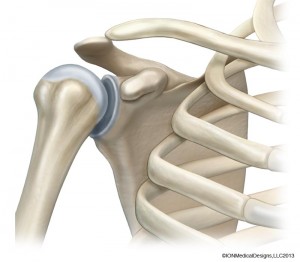The Shoulder

an introduction
The shoulder is one of the most amazing, efficient, and mobile joints in the body. It allows you to throw a ball, scratch your back, pick up your baby, pick up great weight or a little weight, or reach down to tie your shoe. Injury to the shoulder can cause disability, pain and loss of motion.
Shoulder injury can happen to anyone, young or old, active or inactive, athletic or not. There is no single cause of injury. You can injure your shoulder by a single injury or by repetitive injury; by lifting incorrectly or by throwing incorrectly; by a single fall on the shoulder driving it upward or by working overhead repetitively.
Common early symptoms may include pain, stiffness, loss of motion, and/or loss of strength. There can be any combination of symptoms. Pain can radiate into the neck or down the arm though usually not below the elbow. Some pain in the shoulder can actually originate from a neck problem, ruptured disk or nerve irritation; call referred pain.
A good history and physical exam is needed to make a diagnosis. Point tenderness, objective loss of motion both active and passive as well as history of the onset of symptoms and treatment to date all are needed to help with the diagnosis. In many cases, diagnostic tests such as x-rays and an MRI with or without an injection of contrast into your shoulder may be required. Other less often used tests are Ultrasound and CT scan.
Many shoulder problems are treated initially by conservative treatments; steroidal or non-steroidal anti-inflammatories and physical therapy; occasionally injections directly into the shoulder. If these measures fail, then your surgeon may consider an arthroscope.